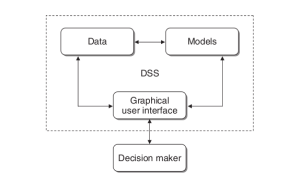In the last post we briefly introduced what a DSS is and what it does. It’s not necessary to read it, but if you really want to you can get it here.
As a quick recap, Decision support systems (DSS) are interactive software-based systems intended to help managers in decision-making by accessing large volumes of information generated from various related information systems involved in organizational business processes. A DSS helps in decision-making but does not necessarily give a decision itself.
There are several ways to classify DSS. From a data representation perspective 5 major classifications can be made.
- Text Oriented DSS: contains information in text form allowing documents to be electronically created, revised and viewed as needed.
- Database Oriented DSS: Driven by a database of organized and highly structured data.
- Spreadsheet Oriented DSS: contains information in spread sheets. A spread sheet makes it easy to create, view, or modify procedural knowledge. It is also possible to instruct the system to execute self-contained instructions.
- Solver Oriented DSS: based on an algorithm or procedure written for performing certain calculations and executing a particular program type.
- Rules Oriented DSS: follows certain procedures adopted as rules.
Despite these differences in classification, all DSS systems have the same general architecture as shown in the figure below.

Another way to classify a DSS is to look at it in terms of the processes and purposes that drive it and it’s target audience. From this perspective several major categories present themselves.
- Communication-driven DSS
This breed of DSS is often called group decision support systems (GDSS). They are a special type of hybrid DSS that emphasizes the use of communications and decision models intended to facilitate the solution of problems by decision makers working together as a group. Most communications-driven DSS’s are targeted at internal teams, including partners. GDSS supports electronic communication, scheduling, document sharing and other group productivity and decision enhancing activities and involves technologies such as two-way interactive video, bulletin boards, e-mail, etc. Examples: chats and instant messaging softwares, online collaboration and net-meeting systems. - Data-driven DSS
Support decision making by enabling users to extract useful information that was previously buried in large quantities of data. Often data from transaction processing systems are collected in data warehouses for this purpose. Most data-driven DSSs are targeted at managers, staff and also product/service suppliers who need to query a database or data warehouse for a specific answer for specific purposes. - Document-driven DSS
These systems help managers retrieve and mange unstructured documents and web pages by integrating a variety of storage and processing technologies to provide complete document retrieval and analysis. These systems provide access to all kinds of documents such as company policies and procedures, product specification, catalogues, corporate historical documents, minutes of meetings, important correspondence, corporate records, etc. and are usually driven by a task-specific search engine.Document-driven DSSs are very common, and are targeted at a broad base of user groups. - Knowledge-driven DSS:
Knowledge-driven DSSs or a ‘knowledge-base’ as they are known, are a catch-all category, covering a broad range of systems users within the organization setting it up. It may also include others interacting with the organization – for example, consumers of a business. It is essentially used to provide management advice or to choose products/services. The typical deployment technology used to set up such systems could be silent/server systems, the web, or software running on stand-alone PCs. - Model-driven DSS
The underlying model that drives the DSS can come from various disciplines or areas of speciality and might include accounting models, financial models, representation models, optimization models, etc. Model-driven DSSs are complex systems that help analyse decisions or choose between different options with the emphasize on access to and manipulation of a model, rather than data, i.e. it uses data and parameters to aid decision makers in analysing a situation. These systems usually are not data intensive and consequently are not linked to very large databases.
A model-driven DSS will most commonly be used by managers and staff members of a business, or people who interact with the organization, for a number of purposes depending on how the model is set up – scheduling, decision analyses etc. These DSSs can be deployed via software/hardware in stand-alone PCs, client/server systems, or the web.
There’s a lot more than can be said about types of DSS. For more information visit:
http://www.referenceforbusiness.com/small/Co-Di/Decision-Support-Systems.html
http://www.gdrc.org/decision/dss-types.html
In the next post we explore the features and characteristics of a DSS.